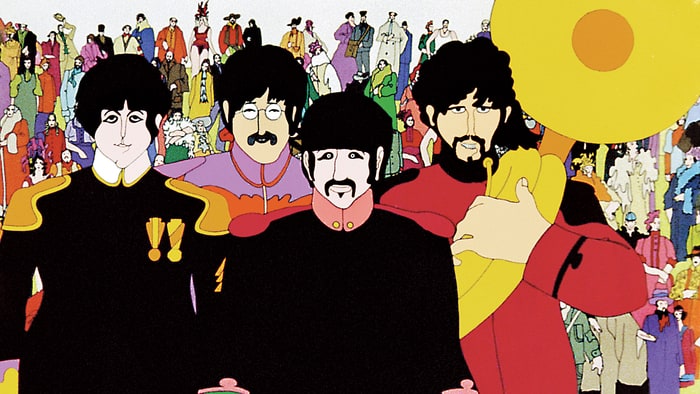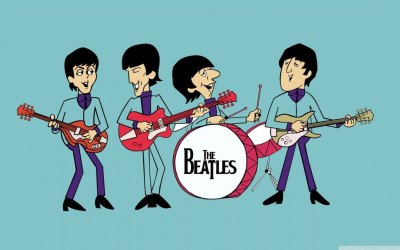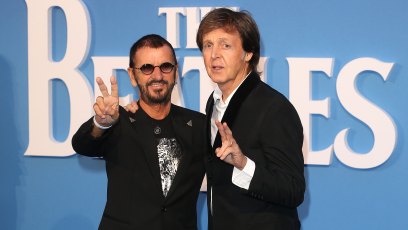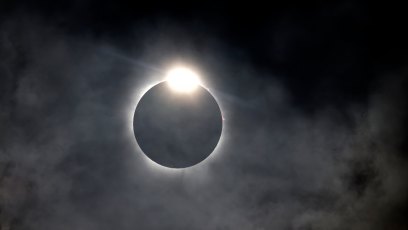
Apple Records
Set Sail With The Beatles’ ‘Yellow Submarine’ for Its 50th Anniversary (EXCLUSIVE)
Armed with their music and the most powerful weapon of all, love, The Beatles must stop the Blue Meanies from destroying everything near and dear to the people of Pepperland. Such is the premise of the animated movie Yellow Submarine, which, in celebration of its 50th Anniversary, is returning to select theaters for special showings. And joining it will be the making of book, It’s All in the Mind: Inside The Beatles’ Yellow Submarine, Vol. 2; and the graphic novel adaptation of the film from writer/artist Bill Morrison and Titan Comics.
Back at the height of Beatlemania in the mid-1960s, the Fab Four (you know, John Lennon, Paul McCartney, George Harrison, and Ringo Starr) signed a three-picture deal with United Artists, resulting in the box office (and soundtracks) hits A Hard Day’s Night (1964) and Help! (1965), after which their interest in a follow-up was virtually non-existent. Al Brodax, who had produced a Saturday morning animated series based on the band (which they despised), struck a deal for an animated film that wouldn’t require The Beatles to provide their voices and only four songs. As things would turn out, though, this did not end up fulfilling the group’s contractual obligation, despite the fact they made a live-action cameo appearance at the end (sorry, Fabs).
“We never had any idea of including them at all,” Al told Beatlefan magazine. “What happened was they wanted to see the footage. Ringo was the most interested and his only complaint was that his nose was not quite long enough. But they loved what they’d seen; they’d never seen anything like it, and they demanded, almost, that they be in the film. I had the idea, a promotional idea, really, about John’s warning of Blue Meanies surrounding the theater. That’s how they got into the movie.”
Saturday Morning Beatles
The Saturday morning Beatles cartoon that preceded Yellow Submarine consisted of mini-episodes, the plots of which were inspired by the group’s songs. The fabs themselves were voiced by other people who, frankly, sounded nothing at all like them, and for every person who loves the show, there’s another that simply doesn’t get it.
“Al Brodax was the stereotypical New York fast-talking producer, heavy on the schmooze factor, cigar chomped in his teeth,” explains Laura E. Cortner, co-author with Dr. Robert R. Hieronimus of the books Inside the Yellow Submarine and It’s All in the Mind, in an exclusive interview. “His chutzpah resulted in one of the hundreds (thousands?) of licensing deals that Beatles manager Brian Epstein arranged at the height of Beatlemania, which resulted in the cartoon that ran for three years on ABC to enormous ratings. He farmed out the work to a young animation company in London run by George Dunning and John Coates. None of them liked the cartoon series, they just cranked them out week after week, framing loose slapstick plots around the new songs as they came out. The caricature style was out-dated already, and The Beatles themselves especially hated the series, saying it made them look like the bloody Flintstones.”

(Photo Credit: YouTube)
Mitchell Axelrod, author of Beatletoons, the only book written about that series, shares with us, “The Beatles cartoon series was so enormously successful that Brodax wanted to take advantage of this success and make a full length animated film version. Why mess with a very good money-making thing? As a matter of fact, very early on in the process of envisioning a feature film, there was an ad in Variety magazine in December 1965 announcing four new half-hour Beatles cartoons specials in progress. This was to be the film, but that was thwarted very quickly by The Beatles’ management, who had a very different vision for a Beatles animated feature film. To me, the Beatles in Yellow Submarine are the animated series Beatles after having gone through puberty. Deeper voices, facial hair, and more grown up.”
This film was not designed for Disney audiences.
Laura notes that Brodax “badgered” Brian Epstein for the rights to do an animated feature, and finally convinced him with the argument that it would fulfill their contract with UA. The producer immediately went back to Dunning and Coates to create a 90-minute version of the Saturday morning series, and was turned down.
“Dunning, in particular, was an innovative artist,” she explains. “Can you imagine being invited, as Dunning and Coates were, by [Beatles record producer] George Martin to a private listening session at Abbey Road and hearing the first pressing of Sgt. Pepper before anyone else? After that, they were convinced that The Beatles had moved so far beyond the moptop image, that to freeze them in time like that in a feature film would do them all a disservice.” Then they became interested in the animated project, Laura notes: “They were so inspired, they dove into an impossible task, determined to create the visual equivalent of that magnum opus in less than a quarter of the time and with less than a quarter of the budget of a typical Disney film. It was Dunning and Coates, and their crew of animators, who determined to make Yellow Submarine a celebration of 60s youth rebellion and a highpoint of hippie ideology and culture.

(Photo Credit: Getty Images)
“From an artistic standpoint,” she continues, “it is a veritable encyclopedia of animation styles. You can see clearly which scenes influenced the Monty Python animation style that followed, and why the creator of The Simpsons and the head of Pixar Animation Studios, among others, count this film as starting them in their chosen field, and providing hours of ideas for their own projects that followed.”
Love rules over hate thanks to The Beatles.
For his part, Robert reflects, “I was immediately captivated when I saw it originally in the theaters in 1968, and as an artist and a student of mythology and symbolism, I became obsessed with finding out who had created such a brilliant message in a colorful avant-garde cartoon. It makes people happy, it resolves conflict with peaceful resolutions, it introduces new generations of children to Beatles music every year, and essentially secures their longevity in pop culture by freezing their images in time as forever young and beautiful and groovy. But mainly for me, the thing I find most inspiring about this film is its message to all Earth people that ‘We Are One’: The Blue Meanies, the Nowhere Man, the Bluebird of Happiness, The Beatles, and Sgt. Pepper’s Lonely Hearts Club Band are all part of the same family.”

(Photo Credit: Getty Images)
As described above, in some ways it would seem that Yellow Submarine is such a product of its time that it would be difficult for modern audiences to identify with it, yet there was a major push on DVD and then Blu-ray within the last 20 years, there continues to be a lot of merchandise inspired by the film, and now, of course, there’s the theatrical re-release, making of the book, and graphic novel.
“If it is obscure to a younger audience or to casual Beatles fans,” says writer/artist Bill Morrison in an exclusive interview, “then I’m excited to introduce them to it through this book. It has a great message of love and peace, and changing people’s hearts and minds that resonates today. Both the film and book are visually exciting and the characters are really fun and memorable, so I don’t have any doubts that it will work for a modern audience.”
“I think any modern audience of any era will relate to the essential plot of this film, such that it has a plot at all, and that is the endless battle of Good vs. Evil,” suggests Robert.
Bill comments, “We’re in very turbulent times, much akin to the late 1960s when this film was created, and I think the message of peace and love has as much impact as it did back then. The idea that ‘all you need is love’ to conquer hatred and evil is still a very hopeful message. And beyond that, the meaning of Yellow Submarine is that evildoers can be redeemed and changed for the better. So it’s not just about beating hate and winning a war, but also changing the hatred to love.”

(Photo Credit: Getty Images)
When asked her views on the film’s storyline, Laura opines, “It’s almost not fair to call it a storyline. A good part of this film was made without a script because they couldn’t decide on which script to use and the animators had to work on something while waiting for dialogue, which usually meant the musical sequences. That it makes any sense at all, in the end, is nothing short of amazing. One of the main screenwriters ended up being Erich Segal, who later went on to fame as the author of the best selling book and film Love Story. Segal was a professor of classics at Yale at the time, and he managed to produce a coherent plotline by following the classic pattern of Separation (the Submarine leaves Pepperland), Initiation (traveling through the Seas of Monsters, etc.), and Return (the heroes return to Pepperland and vanquish the Blue Meanies). I believe it’s this connection to these archetypes and patterns that are ingrained in humanity’s unconscious that give power to this film. But let’s be honest: the real power of the film comes from the power of The Beatles. As with almost everything they touched, it became bigger than the sum of its parts.”

(Photo Credit: Getty Images)
Back in 1999, as part of the promotion of Yellow Submarine on DVD, Paul McCartney reflected, “When the guys who made the film first came to London saying they wanted to do this feature film, because at the time I lived in town and the others didn’t, they came around to see me to talk about it. I was actually sort of imagining a kind of Disneyesque look, because I am a big fan of that kind of old animation — Dumbo, Snow White, Lady and the Tramp. I think those are really great classics. So I was kind of steering it a bit in that kind of direction. Unfortunately, it was the middle of the ‘60s and it was in the middle of this wild thing happening in London. We’d just made Sgt. Pepper and they felt they had to pick up on that, quite rightly. So my main point was that we could make a great kids’ cartoon and they kept saying, ‘No, we’ve got to pick up on the spirit of the times.’ I think they were right, and that’s exactly what they did. The film’s very much got a ‘60s feel in the colors, the jokes, and the whole idea. And I think it’s quite a good metaphor for life — the Blue Meanies on one side and then the ‘All You Need is Love’ people on the other. I think that still stands up and it probably always will.”
At first, The Beatles didn’t care about the film.
The irony of that statement, of course, stems from the fact, as previously noted, The Beatles could care less about the film… at first. Gradually, though, they came to realize that something special was being created.
“Originally they wanted nothing to do with it for a few reasons,” Mitchell details. “The first is that they had a bad taste in their mouths from the animated cartoon series (although they never stopped cashing the checks). They never really fell in love with how they were portrayed in the series. Another reason was that they were trying to find themselves spiritually and were traveling and didn’t have the time to spend in a studio for months voicing themselves. They were also in the studio full time making records while Yellow Submarine was being produced. But after seeing some of the daily rushes, they were impressed enough to be persuaded to be filmed for the action-ending segment, which is fun.”
Their lack of involvement was actually one of the great revelations for Robert in co-writing his books with Laura. “Up until 1999 and the re-release of the film, Apple and The Beatles had remained publicly quiet about Yellow Submarine, allowing common myths and misperceptions to develop over the decades, the biggest one being the mistaken assumption I and millions of others made in 1968 that this was a Beatles’ film,” he laughs. “I really thought they were geniuses there for many years, giving them all the credit in my mind for this classical odyssey of brilliant color and design with such a powerful humanitarian message of lasting peace. It was not until the late 1970s and early 1980s that I was able to track down enough data to establish just how many people were involved, and the late 1980s when I began tracking down these people myself to interview them, that I would believe that The Beatles had practically zero input beyond lending their likenesses and music to be shaped into this creation by others.”

(Photo Credit: Getty Images)
Laura notes that George Martin related to them that originally The Beatles “hated” the idea of the film. “They thought they were being sold down the river on this deal,” she relates him saying. “Consequently, they gave it the cold shoulder and told him they were not going to give him very much help on the soundtrack.” Additionally, she quotes George, “Whenever we were working on a song that we didn’t like too much, or wasn’t that brilliant of one, they would say, ‘OK, let’s put that one aside; that will do for the Yellow Submarine.’ That was the attitude.”
“They went off and made their own film, Magical Mystery Tour, then they went to India, then they recorded The White Album,” Laura relates. “They were too busy to be involved even if they wanted to be. But they were very surprised when they saw the film near its complete stage. Beatles press officer Tony Barrow told us, ‘When The Beatles actually saw Yellow Submarine, they were genuinely shocked that [Brian Epstein] had written off the entire project so casually. By this time, it was difficult for them to start lavishing praise on the production in public, having paid so little personal attention to the making of it. But, in private, insiders heard them speak highly of the spectacular and innovative animation techniques. They hadn’t expected to find the film so enjoyable. In separate conversations with me at the time, both John and Paul expressed belated disappointment that they hadn’t involved themselves far more actively in the production. John was particularly taken with… the belligerent Blue Meanies and menacing Apple Bonkers!’”
With the return of Yellow Submarine, while Mitchel Axelrod agrees that there are elements of the film that are a little dated, he emphasizes, “You have to understand that for many people, the cartoon series and especially Yellow Submarine were the very first times that a lot of us saw, and fell in love with, The Beatles. That appeal will never fade and the film holds a very special place in the hearts of so many around the globe. As long as first-generation Beatles fans still enjoy it, and show it to their kids and grandkids, I don’t think the film will ever lose its appeal.”
Yellow Submarine sets sail on the big screen July 8 in select theaters.







































